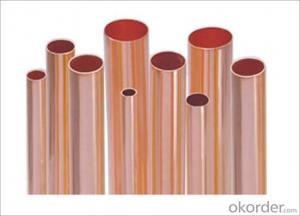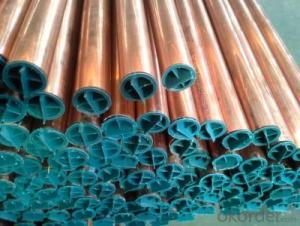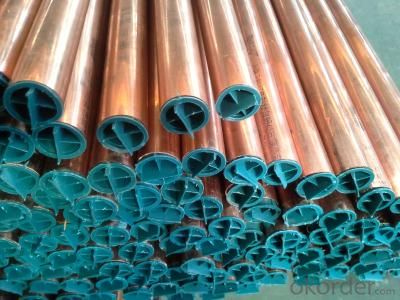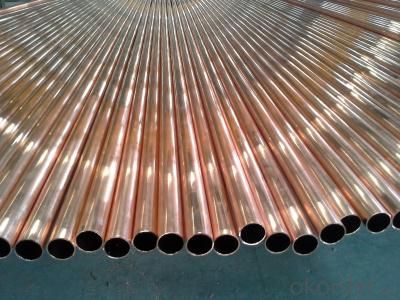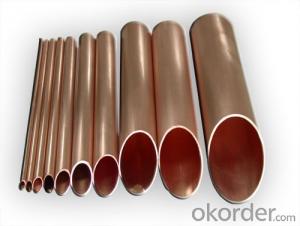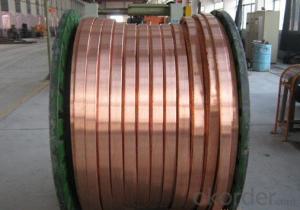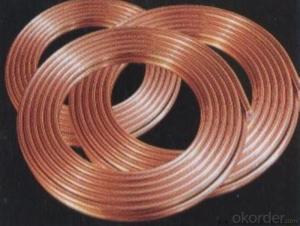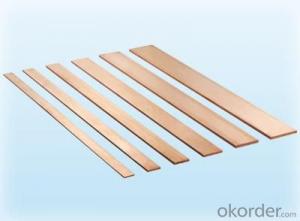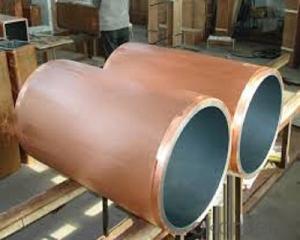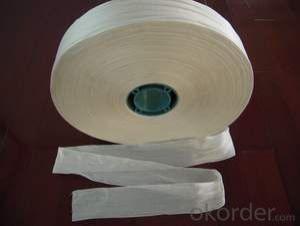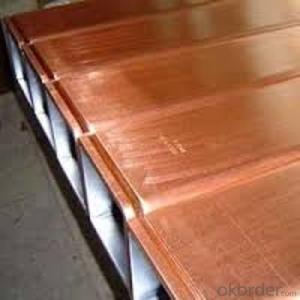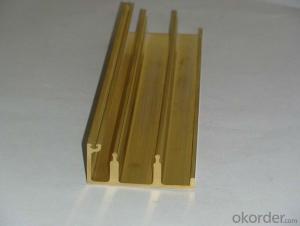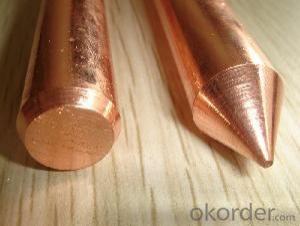New Refrigeration Copper Pipe for Refrigeration System
- Loading Port:
- Shanghai
- Payment Terms:
- TT OR LC
- Min Order Qty:
- 500 kg
- Supply Capability:
- 10000 kg/month
OKorder Service Pledge
OKorder Financial Service
You Might Also Like
New Refrigeration Copper Pipe
Model: TP2、TU1、TU2、T2
Application:
Primarily applied in household and commercial central air conditioning system; pressure resistant product made by large water seal extruder through degrease process, without residual oil and with low dust load, suitable for refrigeration systems using new refrigerant
Type Specifications: TP2, TU1, TU2, T2
Primarily applied in household and commercial central air conditioning system; pressure resistant product made by large water seal extruder through degrease process, without residual oil and with low dust load, suitable for refrigeration systems using new refrigerant
Specifications:
Item | air conditioner copper pipe |
Type | straight copper pipe,pancake coil copper pipe,capillary copper pipe |
Standard | GB/T1527-2006,JIS H3300-2006,ASTM B75M,ASTMB42,ASTMB111,ASTMB395, ASTM B359,ASTM B188,ASTM B698,ASTM B640,etc |
Material | C10100,C10200,C10300,C10400,C10500,C10700,C10800,C10910,C10920, C10930,C11000,C11300,C11400,C11500,C11600,C12000,C12200,C12300, C12500,C14200,C14420,C14500,C14510,C14520,C14530,C17200,C19200, C21000,C23000,C26000,C27000,C27400,C28000,C33000,C33200,C37000, C44300,C44400,C44500,C60800,C63020,C65500,C68700,C70400,C70620, C71000,C71500,C71520,C71640,C72200,etc |
Shape | Round,Square,Rectangular,Oval,half-round |
Outside diameter | 4.76-28.58mm |
Wall thickness | 0.4-1.5mm |
Length | 1m,2m,3m,6m,or as required |
Hardness | 1/16 hard,1/8 hard,3/8 hard,1/4 hard,1/2hard,full hard,soft,. |
Surface | mill,polished,bright,oiled,hair line,brush,mirror,sand blast,or as required |
Price Term | Ex-Work,FOB,CNF,CFR,CIF etc |
Payment Terms | TT,L/C etc |
Export to | Singapore,Indonesia,Ukraine,Korea,Thailand,Viet Nam,Saudi Arabia,Brazil,Spain,Canada, USA,Egypt,Iran,India,Kuwait,Dubai,Oman,Kuwait,Peru,Mexico,Iraq,Russia,Malaysia,etc |
MOQ | 2 tons |
Package | Standard export package ,or as required. |
Application | Copper pipe have strong, corrosion resistant properties, and become a modern contractor in all of commodity house pipes, heating, cooling water piping installation of choice |
Contact | If you have any question ,please feel free to contact me we are sure your inquiry or requirements will get prompt attention |
Production Equipment
750-1500kg main frequency induction copper melting furnace, 80MN water seal extruder, LG60 high speed two-roll cold pilger mill, straight-line wire-drawing machine, copper tube/pipe straightener, polisher, 84′ copper coil winding machine, straightening-cutting & pancake coiling machine, thermoplastic packaging machine, 1.2T continuous bright annealing furnace.
Testing Devices
spectrum analyzer, atomic absorption analyzer, spectrophotometry, analytical balances, metallurgical microscope, eddy current flaw detector, metal tensile testing machine, eddy conductivity instrument.
Process
refined copper — smelting & casting — extrusion — rolling — drawing — straightening-cutting/forming of pancake coil — bright annealing — packaging — finished goods.
Standards
GB/T 1527-2006 Drawn tube of copper and copper alloys
GB/T 16866-2006 Dimensions and tolerances of copper and copper alloy seamless tubes
GB/T 4423-2007 Copper and copper-alloy cold-drawn rod and bar
GB/T 5231-2001 Wrought copper and copper alloys chemical composition limits and forms of wrought products
GB/T 5585.1-2005 Copper or aluminium and its alloy bus bars for electrical purposes—Part 1:Copper andcopper alloy bus bars
GB/T 17791-2007 Seamless copper tube for air conditioner and refrigeration equipment
GB/T 19850-2005 The seamless round copper tubes for electrical purposes
GB/T 26024-2010 Seamless copper and copper alloys tube for valves on air-conditioning and refrigeration system
ASTM B280-2008 Standard Specification for Seamless Copper Tube for Air Conditioning and Refrigeration Field Service
EN 12735-1:2001 Copper and copper alloys Seamless,round copper tubes for air-conditioning and refrigeration Part 1:Tubes for piping systems
EN 12735-2:2001 Copper and copper alloy – seamless round copper tube/pipe for air-conditioning and refrigeration system – for equipment
JIS H3300-2009 Seamless copper and copper alloy tube/pipe
- Q: Where are copper pipes mainly found?
- they were often used for plumbing projects of various kinds. carry clean water, set up a moonshine still, carry out drain and waste water science labs b/c of durability, and minimal interaction with other stuff. plumbing store? {sorry, couldn't resist.} metal recycling places {couldn't leave that one out, either}
- Q: What would be a good science experiment (cant use any expensive equipment) on copper sulfate and how would i test it?
- Sabrina..you can make a copper sulfate crystal garden as a visual demonstration of osmosis. Make a solution ( ~ 15 % vol/vol ) sodium silicate in water ( sodium silicate is sold in drug stores as liquid glass and is a non-organic glue ). Place the solution is a small bowl , then add a crystal of copper sulfate ( the crystal should be about 1-2 mm in diameter.. the size of a large pinhead). After about 10 minutes the crystal will begin to grow into a spar -shaped blue crystal..much, much larger than the tiny crystal of copper sulfate . This is because the small crystal of soluble copper sulfate becomes coated with the insoluble copper silicate that forms a semipermeable membrane .At that interface as water moves in to dissolve the copper sulfate the rapidly forming copper silkicate seals the surface and the crystal burgeons with the water. Placing many of the copper sulfate cyrstals in the bowl will produce a forest of bluish spars . Using other salts like cobalt chloride ( dark blue spars ) or ferric chloride ( yellow spars ) or nickel chloride ( green spars ) will produce a very colorful garden of colors . As long as the metal chosen forms an insoluble silicate it will work
- Q: I have some Wardley Shrimp Pellets and I see copper sulfate in the ingredients...won't this harm my inverts? (Blue lobster, fiddler crabs, dwarf shrimp)
- It is only a trace amount but I would avoid any copper with inverts. It does not take much to kill snails for example. Invertebrates, like other living things, do need a trace of copper in their food. Some of them even use copper instead of iron in their blood, which makes it blue or even green instead of red. It is common to simplify and say all invertebrates have copper based blood. The naturally present copper in foods is the safe way to obtain what is needed. Using a food with copper supplemented is unnecessary. Copper supplements, like copper containing medications, can precipitate in the aquarium and build up. Then with some shift in water parameters such as pH, temperature, or hardness, all of the stored up copper goes back into solution. There would be no problems with the copper additive until there was something else handy to blame it on. You would have just done a partial water change and automatically guess that the water company put some toxic chemical treatment in the water supply. If you want to see what a little copper sulfate can do, look at the pictures in this link below. It can change the color of hardened concrete.
- Q: An alloy of metal is 25% copper. Another alloy is 50% copper. How much of each alloy should be used to make 1000 grams of an alloy that is 45% copper?
- 25% of alloy x is copper 50% of alloy y is copper You want to use x+y to make 45% of 1000 grams copper You may be able to continue from my re-stating the problem. I used to teach, so I don't just give answers!
- Q: How do we get pure copper?
- Copper okorder
- Q: Would it be worth it to save a lot of pennies and then sell it at a place where they buy copper?
- It costs more to make a penny than what it's worth due to the zinc that is inside of pennies and the copper coating. In 2007, it was reported that 1.67 cents were spent per penny made.
- Q: I bought an antique copper hip flask from Portebello market (London), when I washed it out with water loads of grime came out. Is it safe to drink hard liquor from it or will I get some sort of copper poisining? I've washed it out with boiling water and fairy antibacterial washing up liquid, what would you recomend I do? thanks in advance :D xx
- Is the flask lined with another metal other than copper, IF NOT, don't use it as you could get cooper poisoning...yes I am serious....If it is lined then use a vinegar,soap &water solution and let it set for a few hours to a day, then rinse it out and clean well, repeat if necessary,if possible use a bottle brush to help get inside.... Be CAREFUL if the flask is not lined, adding liquor (whiskey)is similar to adding bleach to it and drinking it as the alcohol will have an adverse affect on the copper. IF needed contact a copper smith. ntact PAUL REVERE COOKWARE as they use a lot of copper in their products for advice.
- Q: what causes the copper and zinc to desolve, and cause the change of color?
- The following reactions are occuring copper/zinc(s) + nitric acid(aq) ----------> copper/zinc nitrate(aq) + nitrogen oxides(g) + water The metals dissolve because soluble nitrate salts are formed. With copper the colour changes because copper nitrate is blue. Zinc nitrate is white so the solution is colourless. If nitrogen DIoxide is produced it will be seen as a yellow-brown gas. NB This is not the usual reaction of a dilute acid with a metal forming the salt and hydrogen gas and copper does not react with dilute sulphuric and hydrochloric. Nitric acid is an oxidising agent and reacts in this different way with most metals.
- Q: If you dissolve 0.135g of copper in nitric acid and dilute it to 100.0 mL with water, calculate the concentration of Cu^2+ in the resulting solution.Please help me with this question
- Look up the atomic weight of copper in the periodic table. You can assume this the same as the molar mass of copper and use it for the next step. The electrons are negligible, so you can ignore the mass difference between the ion and elemental Copper. Divide the mass of copper by the atomic weight to get the number of moles of copper. Divide the number of moles by the volume of water in liters (100mL = 100 x 10^-3 L) to get your concentration in moles per liter There it is, step by step.
- Q: How do I remove compression fittings from an existing copper pipe?
- For the peace of mind,i would replace the copper pipe and compression fitting to eliminate possible leaking,or a part of the pipe with new compression fitting,i'm sure they are meant to be used once only.
Send your message to us
New Refrigeration Copper Pipe for Refrigeration System
- Loading Port:
- Shanghai
- Payment Terms:
- TT OR LC
- Min Order Qty:
- 500 kg
- Supply Capability:
- 10000 kg/month
OKorder Service Pledge
OKorder Financial Service
Similar products
Hot products
Hot Searches
Related keywords
